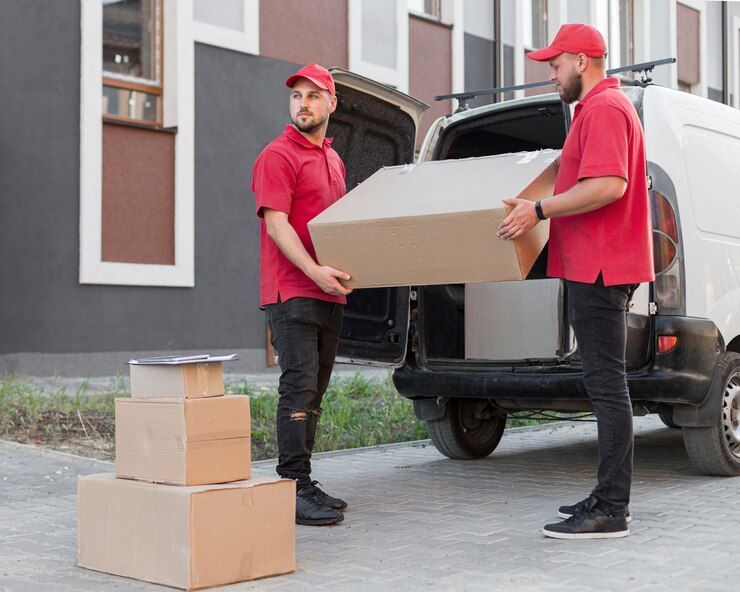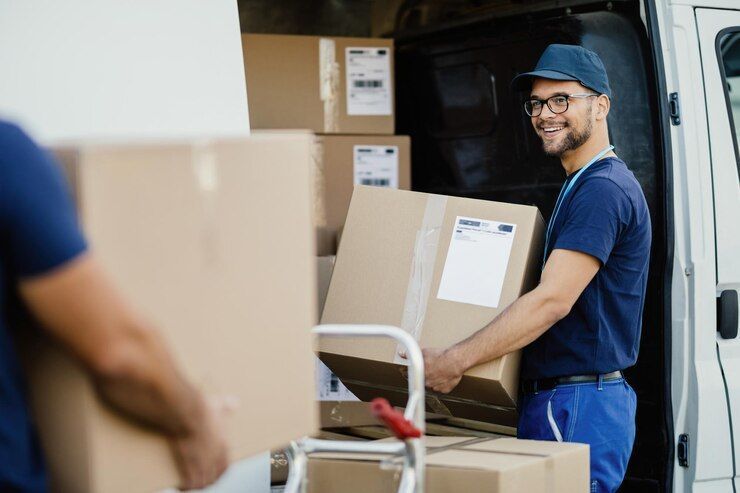Moving Checklist: The Ultimate Guide To A Hassle Free Move
moving checklist: the ultimate guide to a hassle-free move
A new home, a new neighborhood, and new experiences are waiting just around the corner. But let's be honest; it can also be stressful, overwhelming, and, involve a series of reminiscences containing lots of emotional attachments! Besides, moving between packing, organizing, cleaning, and scheduling can seem very difficult!
But what if it doesn't have to be that way? What if there was a map that led you step by step, ensuring a hassle-free move? You're in luck because we've created just the thing!
Our Ultimate Moving Checklist gives you all the necessary information, from choosing the perfect moving date to unloading the last box in your new home. We've got moving tips on organizing, decluttering, packing supplies, and even the nitty-gritty, like changing your address and managing those pesky legal tasks.
So take a deep breath, grab a coffee, and turn that mountain into a walk in the park. With a plan in hand and a guide to follow, you'll find moving can be as thrilling as the life that awaits in your new home. Let's dive in!
Importance of Having a Moving Checklist
If you've ever moved before or changed your neighborhood, you'll know that the process can quickly become chaotic and confusing. There are a hundred little details to remember, and it's too easy to let something slip through the cracks. That's where a moving checklist comes in!
A moving checklist is more than just a list of tasks. It's your roadmap to a smooth and successful move. It gives you a clear outline of everything you need to do, from the big tasks like renting a truck or hiring professionals to the smaller details like canceling your gym membership, scheduling your final utility readings, and salvaging your precious things.
This step-by-step guide means you can confidently approach the moving process, knowing that you've got everything covered. It's like having a personal moving assistant that keeps you organized and ensures nothing gets forgotten.
The importance of a moving checklist cannot be overstated. It's a tool that empowers you to take control of your move, helping you avoid stress and mishaps along the way. After all, moving is a significant life event, and the more organized and prepared you are, the more you can enjoy the journey to your new home.
How the Guide Will Help Readers Have a Hassle-Free Move
Now that we've emphasized the importance of a moving checklist, you might wonder, "How exactly will this guide ensure my moving process is hassle-free?"
This guide is created to be your go-to resource for every stage of your moving journey. It's structured logically, starting with preliminary preparations and leading through to settling in at your new home.
Each section provides detailed advice and steps that break down the moving process into manageable tasks, thus eliminating the stress of figuring out where to start or what comes next. And because it covers a comprehensive range of topics, from sorting and decluttering to legal and administrative tasks, it ensures that no small detail gets overlooked.
Following this guide will equip you with knowledge and strategies to tackle your move efficiently. The moving tips and techniques shared will help you save time and effort, and prevent common moving mistakes. This means less scrambling, less forgetting, and less stress!
Moreover, this guide serves as a reminder to take care of yourself during the move, offering tips on when to take breaks, handling moving day contingencies, and even suggestions on how to adapt to your new environment post-move.
In a nutshell, this guide is designed to empower you with all the information you need for a well-organized, hassle-free move. So let's embark on this journey together, making your move stress-free and enjoyable!
Moving Checklist: the Ultimate Guide to a Hassle-Free Move
1. Preparing for the move
When it comes to moving, a solid preparation phase is the secret to a smoother transition. It's all about making the right decisions for your specific situation. Let's break it down into manageable chunks:
- Choosing the Right Moving Date
Consider choosing your moving date as setting the stage for your relocation journey. It's not just about picking a random date on the calendar; instead, it's about balancing work commitments, school terms if you've got kids, and even the climate. Remember that moving services are in high demand during the summer and weekends, leading to higher costs, so opting for off-peak times might be easier on your wallet if you have flexibility.
- Creating a Moving Budget for the Move
Money talks and its signaling in every step gets more noticeable down the entire process! Relocating comes with many costs that can take you by surprise if you're unprepared. The expenses can stack up from moving supplies to movers' fees and even setting up your new place. To avoid any financial hiccups, outline all possible costs and build a realistic budget. And don't forget to keep a little aside for those unexpected "just in case" situations.
- Hiring a Moving Company vs. DIY Moving
Here comes the big question: to hire or not to hire movers? There's no one-size-fits-all answer here, as both options have perks and drawbacks. Here are some differences that will help you decide -
- Gathering Moving Supplies
Start gathering moving supplies like moving boxes, packing tape, bubble wrap, and markers for labeling early. You might need more than you think, and it's better to be over-prepared than find yourself scrambling for supplies at the last minute. Consider what specialty items, like wardrobe boxes or dish barrel boxes, make packing easier and more secure for your belongings.
2. Sorting and Decluttering
Moving to a new place provides a golden opportunity to reassess what you own and decide what you truly need. It's about more than just reducing the number of boxes to pack. It's an occasion to simplify your life and make your new home less cluttered.
- Assessing Belongings and Making Decisions
It all starts with evaluating what you currently have. Get up close and personal with each item you own. Ask yourself essential questions - Do I use this? Does this add value to my life? Does this hold significant sentimental value? Is any memory attached to this in particular? If the answer to these questions is 'no,' it might be time to part ways with the item. This process can be tough, but remember, you're making way for a new start.
- Organizing Items into Categories
After assessing your belongings, it's time to categorize them. Here are four categories you can sort your items into:
- Keep
These are items that you frequently use or have sentimental value.
- Donate
Things you don't use but are still in good condition can be of great value to others. Donation centers or charitable organizations are always in need of these items.
- Sell
If some items are in good shape and hold some value, why not make some extra bucks? Consider selling these items.
- Discard
Unfortunately, not all items can be donated or sold. Some things are beyond their useful life and need to be responsibly discarded.
- Tips for Holding a Garage Sale or Selling Items Online
You have two excellent options when selling your items - a garage sale or online platforms. A garage sale is a great way to declutter and make money simultaneously. Ensure you advertise locally, price items appropriately, and choose a convenient date.
On the other hand, selling items online can reach a wider audience. Platforms like
eBay
, Facebook Marketplace, or local community pages can be quite effective. Take clear photos, provide detailed descriptions, and set a fair price.
3. Creating a Moving Plan
When it comes to moving, there's a huge difference between doing it and executing it well. The secret to a successful move isn't brute strength or blind luck—it's strategic planning. Let's look at the key elements of a smooth-moving plan: setting a moving timeline, assigning roles, and juggling utilities.
- Setting a timeline for tasks leading up to the move
The first step in your moving plan should be to set a clear, realistic timeline. It's not just about marking the moving day on the calendar; it's about breaking down the monumental task of moving into manageable chunks. A well-thought-out timeline ensures you tackle every task in order, leaving no room for last-minute panic.
- Sharing the Burden: Assigning Responsibilities
If you're moving with family or housemates, it's a team effort. Sharing responsibilities can drastically reduce stress and improve efficiency. It's not just about dividing the tasks; it's about playing to everyone's strengths. One person excels at packing, another at paperwork, and so on. By assigning tasks according to ability, the process can become surprisingly streamlined.
- Keeping the Lights On Managing Utilities
Amid all the physical moving tasks, it's easy to overlook the virtual ones. Transferring utilities should be high on your moving plan. Plan to disconnect utilities at your old home the day after you leave and start them at your new place the day before you arrive. You don't want to end up in the dark after a tiring moving day!
4. Packing Tips and Techniques
Packing isn't just about getting things from point A to point B - it's about doing so with minimal stress and maximum efficiency. However, with the right approach, packing can transform from a chore into a smooth process. Here's how to turn packing into an organized art form.
- Gather the Essentials
Packing is not just about boxes; many other essential supplies can make the process more manageable and secure. Besides sturdy boxes of various sizes, packing paper, bubble wrap, packing tape, and a marker pen are your best allies. You can source these from local stores or online marketplaces specializing in moving supplies. Remember, having more supplies than you need is always better than running out midway through packing!
- Room-by-Room Packing Strategies
Rather than tackling your entire home at once, a room-by-room strategy will make the packing process more manageable and systematic. Start with the rooms you use the least and progress to the most used areas. This method ensures minimal disruption to your daily life and lets you track your progress.
- Fragile items: How to pack them safely
Fragile items require extra attention and care. For delicate items like glassware or antiques, consider double boxing. Pack the item in a smaller box with ample cushioning, then place it in a larger box surrounded by more padding. This provides an extra layer of protection during the move.
- Labeling and Organizing Packed Boxes
Once your boxes are packed, proper labeling is crucial for easy unpacking at your new home. Write a brief description of the contents and the room it belongs to on each box. Consider using a color-coding system for added clarity. Organize the packed boxes so that the ones needed at your new home are loaded last on the moving truck.
5. Moving Large and Special Items
Every home has its unique assortment of items, some of which pose a particular challenge when moving. Larger furniture, appliances, and specialty items like pianos or heavy machinery require a strategic approach to ensure safe transport without breaking them apart. Here's how to tackle these challenging categories.
- Disassembling Furniture and Appliances
Large furniture pieces like beds, wardrobes, and sectionals are usually easier to move when disassembled or dismantled. Similarly, certain appliances may need disconnection and careful preparation.
Always refer to the manufacturer's instructions before you start, and ensure you keep all screws, bolts, and other small parts in a labeled bag. It can also be helpful to take photos during disassembly to aid in the reassembly process at your new home.
- The Art of Moving Specialty Items
Moving special items, such as pianos, antiques, and heavy machinery, presents its own set of challenges. The key lies in careful planning, proper equipment, and if needed, professional help.
For instance, moving a piano involves securing the lid, padding it, lifting it properly, and using a dolly. On the other hand, heavy machinery may require specialized moving equipment and knowledge about safely disconnecting and reconnecting.
Tips for Transporting Electronics and Valuable Possessions
Moving electronics and valuable items is different from shifting your typical household goods. These prized possessions require extra care to reach your new home safely. Let's break down some effective strategies:
- Make a detailed inventory
Before packing, note down your electronics' make, model, and serial number. This will be incredibly helpful if you need to file an insurance claim later. For valuable items like jewelry, consider taking photographs from different angles.
- Back up your data
For electronic devices like laptops and computers, ensure you have a recent backup of all important files. You never know when data loss might occur during a move.
- Use original packaging
Use the original boxes and packaging for your electronics if you still have the original boxes and packaging. They were designed specifically to protect that item.
- Bubble wrap and padding are your friends
For those items that don't have original packaging, use plenty of bubble wrap, foam padding, and sturdy boxes to protect them. Pay special attention to screens and glass surfaces, - particularly vulnerable during transit.
- Remove batteries
If your device uses standard batteries, remove them to prevent potential damage from leakage.
- Climate control
If you are going to make a long distance move or store items, consider a climate-controlled environment. Electronics, artwork, and antiques can be sensitive to changes in temperature and humidity.
- Personal transport
For extremely valuable items, consider moving them personally. This way, you have total control over their handling.
- Insure your valuables
Even with careful planning, accidents can happen. Make sure you have suitable insurance coverage for your high-value items.
Notifying Important Parties
With all the tasks associated with moving, it's easy to forget that people and organizations outside your immediate circle also need to be informed about your new address. This is more than a courteous gesture—it's essential for maintaining uninterrupted communication, receiving necessary services, and ensuring your life continues smoothly after the move.
- Changing your address with the post office
The first thing on your to-do list should be informing the post office of your new address. This way, all your mail will be automatically forwarded to your new home. You can conveniently do this online or at any post office branch.
- Updating your address with banks, insurance, and other institutions
Next, notify your banks, credit card companies, insurance providers, and other financial institutions about your new address. These can typically be done online or over the phone. Ensure to update the information on any automatic payments to prevent any service interruption.
- Informing friends and family of your new address
Of course, remember to share your new address with your friends and family! A simple group email or text will usually suffice, or you could send a traditional moving announcement or change-of-address cards.
- Redirecting subscriptions and deliveries
Remember to update your address for all your subscription services. These could range from your Amazon Prime account to monthly magazine subscriptions, meal kit services, or your favorite online shopping websites.
- Taking Care of Legal and Administrative Tasks
These tasks are vital not only for ensuring a seamless move but also for maintaining your civic responsibilities.
- Transferring medical records and prescriptions
Contact your healthcare providers to transfer medical records and prescriptions to your new location. It's also a good idea to find new healthcare providers near your new home if you're moving far from your current ones.
- Registering your vehicle and obtaining a new driver's license
If you're moving to a new state, you'll need to register your vehicle and obtain a new driver's license. As regulations vary, check your new state's Department of Motor Vehicles website for specifics.
- Registering to vote in your new location
Lastly, don't forget to update your voter registration. Participating in local and national elections is responsible for moving to a new area. Again, check online for the regulations specific to your new location.
Moving Day Preparation
As moving day approaches, preparations intensify. However, amid all the flurry of activities, focusing on a few last-minute tasks is crucial to ensuring a smooth transition on the big day. The following points are paramount and require your attention.
- Packing a moving day essentials box
You've packed your house, but there's one box you need to pack carefully, the "
Essential Box
." This box will contain all the necessities for your first night in the new home. It can include items like toiletries, a change of clothes, necessary medications, basic kitchen utensils, snacks, phone chargers, etc. This box should be marked and easily accessible.
- Confirming logistics with the moving company
If you've hired movers or a moving company, it's a good idea to confirm the schedule and other logistics with them a day or two before moving day. Ensure they have the correct addresses and contact information, and are clear about any special instructions you've given them regarding your belongings.
- Take final meter readings and document the condition of your old home
Moving Day Dos and Don'ts
Moving day has arrived. It's a day filled with excitement, anticipation, glory, and a little bit of anxiety. But, equipped with our guide, you're ready to navigate it like a pro. Here are some dos and don'ts to remember on the big day.
- Supervising the Moving Process
Try to be present and actively supervise the moving process. Even if you've hired professionals, monitoring how your belongings are handled and providing direction when necessary is essential.
- Handling Last-Minute Tasks and Contingencies
Don't panic over last-minute hiccups. There might be unexpected roadblocks—an item doesn't fit through the door, or there's an unexpected delay. Maintain composure, think through the problem, and work towards a solution.
- Taking Care of Pets on Moving Day
Do ensure your pets are well-cared for on a moving day. The chaos and confusion can be stressful for them. Consider arranging for them to stay with a friend or set aside a quiet room where they can stay safe and calm.
- Saying Goodbye to Your Old Neighbors
Don't forget to take a few minutes to say farewell to your neighbors. Goodbyes can be hard, but they bring closure. It's the end of an era and the start of a new adventure.
- Settling into Your New Home
As you transition from moving day into your new life, it's time to settle in.
- Unpacking and Organizing Your Belongings
Unpack systematically. Start with the packing essentials, like boxes, and then move on to the most frequently used rooms, like the kitchen and bedrooms.
- Setting Up Utilities and Services in Your New Home
Don't delay in setting up your utilities and other essential services. If you haven't done it, now is the time to ensure everything runs.
- Exploring Your New Neighborhood and Finding Essential Services
Post-Move Checklist
Once the dust settles and the moving truck drives away, your work isn't over yet. It's time to dive into the post-move checklist, ensuring your new house becomes your home.
- Inspecting and Documenting the Condition of Your New Home
Before you get fully settled, it's important to inspect your new home thoroughly. Document the existing condition of the property with photos or a video walkthrough. This step is crucial, especially for those leasing their property, as it can help resolve any potential disputes about damage down the line.
- Handling Any Post-Move Repairs or Adjustments
The inspection might reveal a few nicks and dings that need attention, or you might want to adjust to better suit your lifestyle. From minor repairs like fixing a leaky faucet to larger projects such as painting walls or installing shelves, tackle these tasks to make your new space more comfortable and personalized.
Tips for Adjusting to Your New Environment and Meeting New People
- Attend community events:
Local events are a great way to meet neighbors and make new friends while learning about your new community's traditions and cultures.
- Join local groups or clubs:
Whether it's a book club, fitness class, or volunteer group, this is a great way to meet people with similar interests.
- Reach out:
Sometimes, a simple hello to your next-door neighbor or inviting them over for coffee can be the beginning of a new friendship.
Additional Tips for a Stress-Free Move
- Start planning your move early
The sooner you start planning, the smoother your move will be. You'll have ample time to get organized, book movers or a moving truck, and handle all the necessary tasks without feeling rushed. Creating a timeline and sticking to it can make the entire process much more manageable.
- Be realistic about your capabilities
It's important to assess how much you can realistically do on your own. If you have numerous large items, delicate valuables, or just an overwhelming amount of stuff, it might be wise to hire a moving company. Professional movers have the equipment and expertise to handle your belongings carefully and efficiently, saving you plenty of time and stress.
- Enlist help from friends and family
Consider asking friends and family for help if your move is more manageable. They can provide additional hands for packing and moving, and their company can make the process more enjoyable. Just remember to show your appreciation with some pizza and refreshments!
- Remember to take breaks
Wrapping Up
Moving houses can be a monumental task. However, armed with the right strategy, moving tips, and comprehensive moving checklist, you can transform this daunting process into a well-organized, manageable project. Remember, every move is unique, and your moving plan should reflect your specific needs and circumstances.
At this point, you're equipped with all the information needed for a smooth, hassle-free move. But remember, even the most meticulous plans can encounter unexpected twists and turns. It's here where an experienced partner like Pro Touch Movers can add value.
Our expertise in handling various moving scenarios can be invaluable in navigating through any unforeseen challenges during your move. We understand the emotional journey you undertake during this period and aim to make it as stress-free and seamless as possible.
At
Pro Touch Movers
, our team strives to provide support beyond moving your belongings. We offer a partnership, a commitment to handle your precious memories with the utmost care, and an unwavering dedication to ensuring your transition to your new home is a joyous journey rather than just a move.
Remember, moving is not just about changing locations; it's also about starting fresh in a new place with new opportunities. We hope this guide helps make that transition as smooth as possible, and remember, should you need that extra professional touch, we're just a call away.


Services
Contact Us
Quick Links
© 2025 All Rights Reserved | Pro Touch Movers









